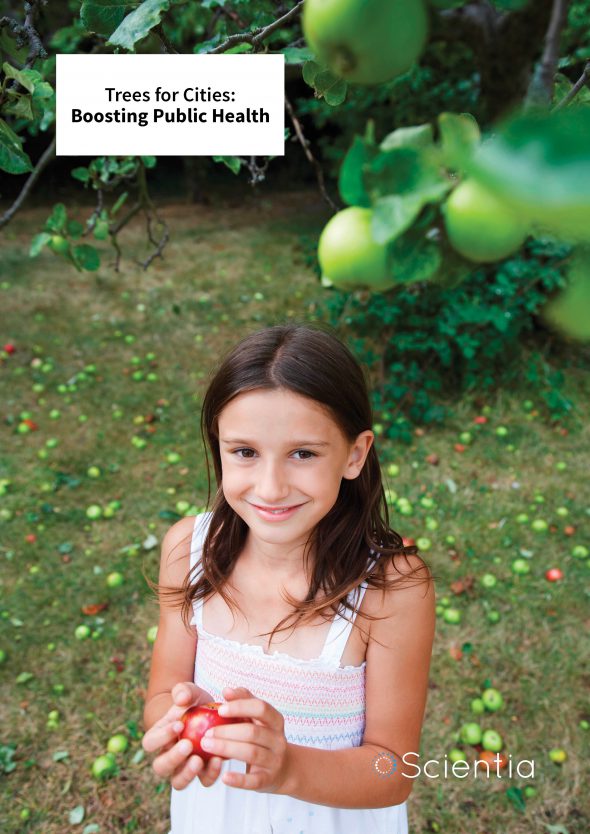Trees for Cities: Boosting Public Health
Trees for Cities – Scientia’s charity partner – has been working on an international scale to create greener cities, engaging over 70,000 people to plant almost 700,000 trees to date. Here, we have had the pleasure of speaking with Kate Sheldon, Development Director and Deputy Chief Executive at Trees for Cities, who describes the many public health benefits associated with having more trees in urban environments.
To start, please explain a few of the many physical health benefits that people can enjoy as a result of having more trees in urban environments?
Urban trees aren’t only beautiful – they perform a vital function to help make our cities healthy places to live. These ‘ecosystem services’ include filtering fine air particles, reducing chemical smog formation, air cooling, and shading out harmful solar radiation, all of which have a positive effect on the incidence of diseases such as asthma, skin cancer and lung disease.
Although most people love urban trees, most don’t realise the full range of benefits that trees provide. In 2005 Trees for Cities worked with the National Urban Forestry Unit to document these benefits in Trees Matter! http://www.treesforcities.org/benefits-urbantrees/. Since then, with advances in IT, some of the ecosystem services provided by urban trees are now quantifiable using models such as i-Tree Eco. In 2015, Trees for Cities was involved in the London i-Tree Eco project – this exemplar project put a monetary value on certain ecosystem services provided by trees in the capital city. The i-Tree approach adds substantial weight to the importance of investment into managing, maintaining and planting urban trees.
Air pollution is currently a hot topic, so using that as an example, the London i-Tree Eco project valued the annual ecosystem service of pollution removal by trees at £126.1 million. Trees remove pollutants by reducing air temperature (which lowers ozone levels) or direct removal – trees with large, sticky or hairy leaves are especially good at this! A study in the West Midlands suggests that doubling tree cover across the region would reduce the concentration of fine PM10 particles by 25%. This could prevent 140 air pollution related premature deaths in the region every year.
‘How the antifreeze glycoproteins, as well as other antifreeze proteins, evolved into functional antifreeze molecules is of much interest to evolutionary biologists’

An abundance of trees in our towns and cities must also have an enormously positive impact on the psychology of city dwellers. How do you think trees can benefit our mental health?
We can all relate to the sense of relief from stepping out of harsh sunlight into the cool shade of tree canopy. Trees are aesthetically very attractive – they soften the hard edges of buildings, and have a wonderfully stimulating yet calming effect. This helps to reduce stress, one of the main causes of ill-health for people in the urban environment.
At Trees for Cities we are strong believers in place-shaping. We plant trees that perform a function and instil a sense of purpose to a space, so that people are encouraged to spend time outdoors and have something to do there. Places such as community orchards and urban woods become a focal point and give residents a reason to meet up to socialise and exercise. These mental health benefits – stress alleviation, reduced anxiety, greater social cohesion, improved self-esteem – all help to prevent ill-health in later life.

Trees for Cities has actively engaged thousands of volunteers to help plant trees in UK cities and internationally – describe how these individuals benefit from such work? On a larger scale, engaging in charitable work must also positively affect the health of communities.
We have network of a fantastic, dedicated volunteers who come out to plant trees with us on cold, wet and windy days each winter. Some live locally to projects, others travel to different sites, and many volunteer through community groups. Whatever their motivation, all our volunteers enjoy a day of physical outdoor activity alongside people from different backgrounds, faiths, ethnicities and ages who share their values and want to engage in doing something positive for the environment.
Trees for Cities has run some fantastically creative volunteer events over the years: the charity began by raising funds through our infamous Tree Parties! ‘Young, Tree and Single’ in Manchester was our first tree planting speed dating, whilst in 2013 we celebrated our 20th anniversary by colouring trees in central London a beautiful shade of blue to raise awareness of their importance. In February of this year, 280 volunteers had fun getting fit at our annual Plant to the Beat urban woodland creation day.
Volunteering has a powerfully uplifting and galvanising effect which has health benefits for individuals and communities. Planting trees instils pride of local green space and supports sustainability, empowering residents to care for their trees and harvest the fruit. This brings people together and builds community cohesion – by planting trees together, we plant hope for the future.

In addition to your amazing work in planting almost 700,000 urban trees to date, Trees for Cities has also developed many ‘edible playgrounds’ and ‘forest gardens’ in schools throughout the UK. Tell us about the many ways in which these gardens benefit children’s health.
We have been planting trees in schools since 1993. Over time, in response to the childhood obesity crisis, we saw increasing demand from Head Teachers to create a resource for children to grow food and encourage healthy eating. In the UK, almost 20% of children are obese on leaving primary school and diet-related illnesses cost the NHS £10 billion each year.
We created our first edible playground at Rotherfield Primary School in 2009. Edible playgrounds provide the practical, functional solution that Head Teachers craved. Our edible playgrounds take a whole school approach and provide a comprehensive service – designing, building raised beds, planting, and providing support for a year through teacher training and planning, linking food-growing to the school curriculum. To date we have created 50 edible playgrounds in London, Reading, Manchester, Liverpool and Sheffield.
School forest gardens take a more naturalistic approach to growing food that mimics agroforestry systems. The benefits of both programmes radiate to the whole school community to create a culture of community food-growing in school and improved environmental awareness.
Finally, I hear that Trees for Cities also works to increase the number of trees in health settings, such as hospitals. Please tell us about your work to date in this regard.
Trees for Cities has been working with the South London and Maudsley NHS Foundation Trust to create a high-quality environment for service users and their families. Maudsley Hospital is a psychiatric hospital in South London. We have created a horticulture therapy garden for adults with severe mental illnesses, and are now embarking on a wider programme to transform the hospital grounds into an accessible community green space. Our planting design has created a place where hospital staff can offer a range of outdoor treatments, from occupational therapy to food-growing, cooking and yoga.
Our focus now is to connect hospitals with their local parks, which provide additional green space and facilities that help to improve the hospital experience. Across a busy road from Maudsley hospital, Ruskin Park offers an ideal location, where Trees for Cities runs tree trail walks, community training sessions and offers free surplus fruit and vegetables grown in the community garden.
Trees for Cities needs your support: please donate at www.treesforcities.org/donate

